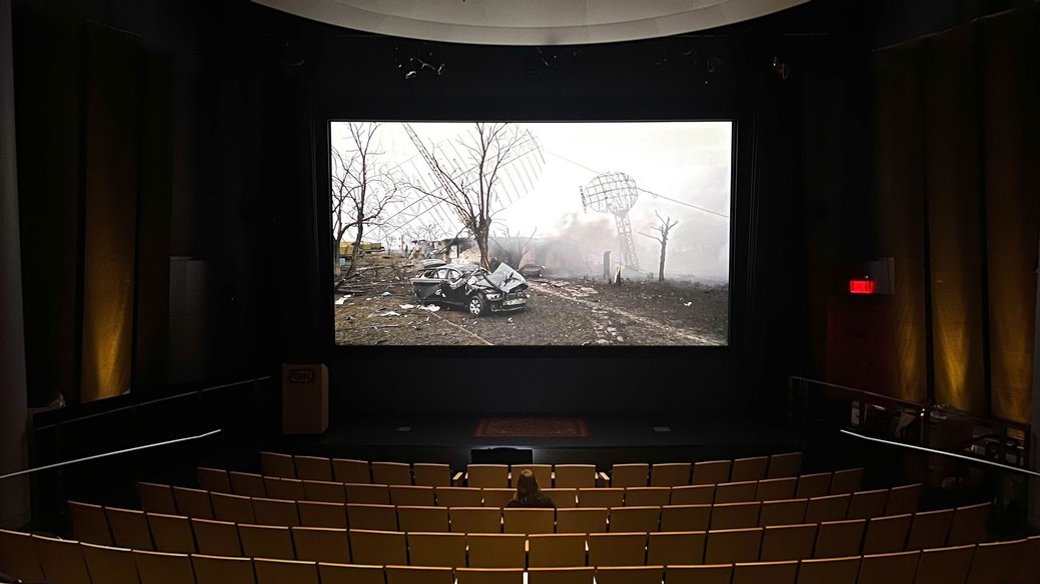
20 Days in Mariupol is truly heart-wrenching. Seventeen minutes into the documentary film, a child's death is captured on screen—one of the earliest victims of the Russian army’s shelling of Ukrainian cities and villages following the events of February 24, 2022. As the film unfolds, the chilling reality of the initial days of full-scale invasion seeps through the screen, accompanied by flashbacks that intensify feelings of anxiety and boundless anger.
Some say that the film should only be watched on the big screen—that way, they argue, there will be fewer chances to interrupt the viewing of this undoubtedly important testimony of Russia’s crimes in Mariupol. Some opt for home viewing (like me, as I had access to a screener copy before voting for the Cine Circle Award, where the film ultimately received two awards) and stretching the painful ninety-minute experience into five nocturnal hours, causing the sounds of explosions in the film to blend in the consciousness with the sounds of explosions heard in Kyiv that morning. Others will say, “This film is a must-watch,” however, when saying this, it is important to understand who will be watching it and when.
It’s still unclear how the American film academics who are members of the Documentary Branch of the Academy select the films in the documentary categories for nomination. According to the rules, the winners will be chosen by these film academics after watching all the nominated films. 20 Days in Mariupol by Mstyslav Chernov, a Ukrainian photojournalist, writer, and now a director, is one of the documentary films that has been nominated for an Oscar.
The film was submitted for two categories: Best International Feature and Best Documentary Feature. Ultimately, it was selected for the latter. This development comes amid frequent reports of Ukrainian films making their way into the competition programs of prestigious international film festivals and represents the next level of visibility for Ukraine and its arthouse cinema in the world.
Formally speaking, this isn’t Ukraine’s first Oscar nomination. Last year, the film The Distant Barking of Dogs directed by Danish filmmaker Simon Lereng Wilmont and filmed in Ukraine with producers Darya Bassel and Victoria Khomenko, received recognition in the documentary feature category.
However, the Oscars nomination for 20 Days in Mariupol prompts us to draw several conclusions, particularly considering the dismal outlook for artistic cinema in Ukraine. (A brief clarification: by “arthouse cinema,” I mean films that explore innovative forms of storytelling, experiment with themes and presentation, and employ cinematic language—films that, while seeking an audience, are not solely driven by financial motives or propaganda.)
While the film didn’t secure a spot among the final five nominees for Best International Feature (a category which seldomly includes documentaries), it did make the shortlist. This achievement marks the farthest any film submitted by the Ukrainian Oscar committee has ever progressed in all its years of operation.
The last opportunity for Ukraine to potentially nominate a film for the Oscars was in 2014, with The Tribe directed by Myroslav Slaboshpytskyi. This groundbreaking debut, which garnered significant acclaim and awards, portrayed the experiences of coming of age in a boarding school for deaf children. Their lives served as a metaphor for a closed society where survival outweighed all else, leaving little room for love. The Tribe introduced a unique aesthetic to Ukrainian cinema and signaled the emergence of a new wave. Despite its success at Cannes and other festivals, as well as positive reviews from the international press, the composition of the National Oscar committee at the time failed to recognize the film’s artistic merit. Consequently, Ukraine submitted Oles Sanin’s Guide for Academy Award consideration, which sparked quite a scandal. However, the committee remained steadfast in its decision.
Since then, the question “What does a Ukrainian film need to win an Oscar?” has been one of the most popular in our media during the Oscar season. 20 Days in Mariupol has not yet received the statuette (although the chances are high), so, jumping ahead, one can assume the answer: the film must be present in the US media sphere, have either American co-producers who believe in the film and promote it in the media, buy billboards, and organize screenings for academy members, or tremendous festival success and almost viral press, like The Tribe had back in the day.
Since the resounding success of Slaboshpytskyi’s debut, a decade has passed, during which Ukrainian cinema has produced hundreds of new feature-length and short films. Some have achieved notable success, while others have struggled to find their footing, varying in innovation and timeliness. Yet, beyond these individual works, Ukrainian cinema has been engaged in a continual process of self-discovery and connection with audiences, both at home and abroad. Numerous articles, reviews, interviews, and even books have delved into this phenomenon. It’s evident that the time has come to reflect on the achievements and evolution of Ukrainian cinema in the post-Maidan decade—the crest of the new wave of Ukrainian cinema appears to be on the horizon.
The full-scale invasion unfolded at a juncture when Ukrainian directors still had work to show, as evidenced by premieres at Cannes and other prestigious venues in 2022. However, the number of films showcasing Ukrainian culture in international film festivals is expected to significantly decline this year. This decline can be attributed in part to nearly four years of stagnation resulting from inadequate funding and ineffective management in the film sector. January 29 marks the four-year anniversary since Maryna Kuderska assumed the position of head of the Ukrainian state film agency. The results of her “work,” for lack of a better term, have been candidly evaluated in various open letters, interviews, and articles.h
One can boldly assume that if the creators of 20 Days in Mariupol had relied on the will of the Ukrainian state film agency, this film would never have been made, at least not in a timely manner.
The crucial feature of this film, generally speaking, is that it was created by people from outside the cinematic bubble.
Mstyslav Chernov, a journalist, photographer, and videographer working for the Associated Press, along with Evgeniy Maloletka, Vasilisa Stepanenko, and Lori Hinnant, received the Pulitzer Prize for their coverage of the siege of Mariupol. At some point, they realized that they were the only journalists left in the city continuing to work and document what was happening to the city during the Russian military’s advance, including its relentless shelling of residential areas and other acts of terror. In one interview, Chernov, who has experience creating longer narrative forms (he is the author of the novel The Dreamtime), said that at a certain point during their work in Mariupol, he began to understand that they could create something more than just news reports for the Associated Press.
In the documentation process, a distinct format emerged: raw videos captured in the city were presented within the framework of foreign news broadcasts, featuring reports on the ongoing events. Concurrently, Chernov’s personal narrative provided additional insight as he explained his actions, reflected on them, and questioned himself both as an individual and as a professional. This amalgamation of perspectives renders 20 Days in Mariupol intriguing to foreign viewers, although the term “intriguing” may seem inadequate given the film’s portrayal of crimes and its artistic treatment of suffering and death.
One can only hope that thanks to this artistic form, the world will pay closer attention to what Russia has done in Mariupol—especially after the name of this city appeared on a beautiful screen in the Beverly Hills theater on January 23, 2024, during the announcement of the Oscar nominees.
Venturing beyond conventional avenues, exploring alternative funding models, and utilizing diverse networking methods appear to be a potential lifeline for Ukrainian cinema. Currently, the industry finds itself caught between diminishing international attention and a state apparatus that predominantly focuses on television production, often masking incompetence under the guise of “patriotism” and “documentation of war crimes” (even though the Ukrainian state film agency’s understanding of such matters is questionable). Additionally, many emerging talents from the Ukrainian New Wave are eager to progress and already have plans for subsequent projects, including second, third, and even serialized productions.
Are other cultural spheres prepared for this cross-pollination, considering not all residents are abreast of the latest in Ukrainian cinema? Is the film community receptive to new collaborations? Is Ukrainian legislation conducive to such endeavors, or does it lean towards restriction rather than facilitation? Ultimately, are the creators themselves prepared for this shift? Amid the immense challenge of full-scale war, grappling with additional hurdles—initially political, now professional and existential—is undeniably daunting. We are also contending with professional crises and undergoing self-reassessment within creative fields.
Nevertheless, as grandiose as it may seem, Ukrainian producers, directors, curators, and selectors’ responses to this challenge will ultimately shape the future of Ukrainian cinema.
Text originally published (in Ukrainian) by Suspilne Kultura as part of a collaboration with Documenting Ukraine.
Translated by Kate Tsurkan

